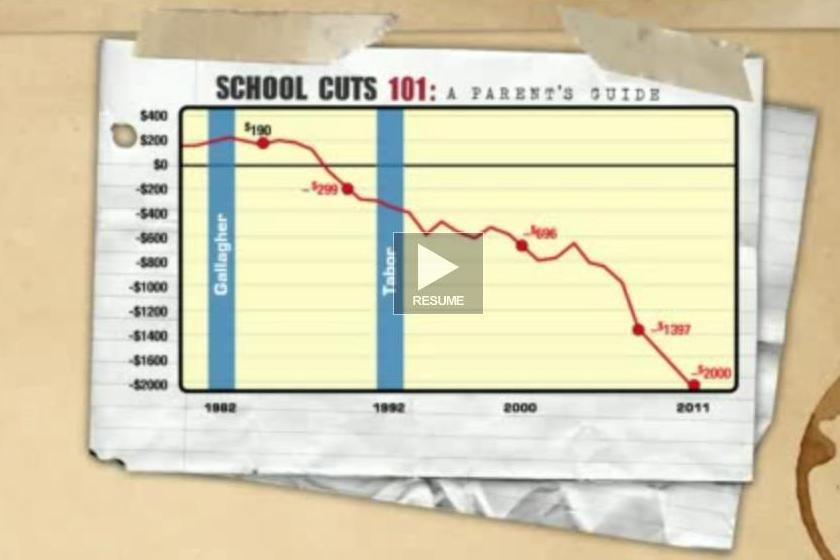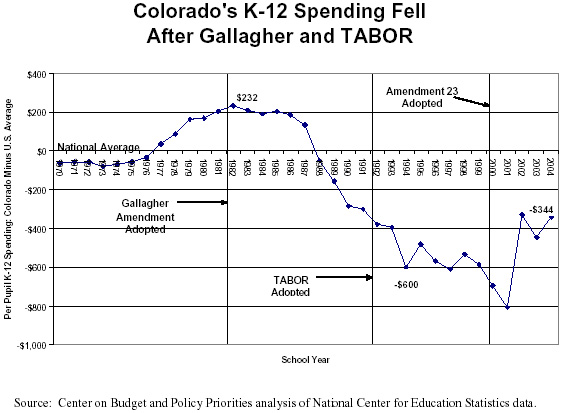Originally posted at Colorado Peak Politics. Re-posted here with permission.
By Ben DeGrow
Local FOX 31 Denver News and reporter Eli Stokols are to be commended for wanting to look at the effects of K-12 education spending cuts and innovative ideas for addressing the challenge. But the first edition of the televised series cries out for context and correction. First of all, it’s important to stress that yes, for the past couple years Colorado schools have been experiencing real budget cuts — after years of steady increases in per-pupil funding. And of course, the cuts will have an impact, albeit an impact that can be heavily mitigated and overcome in the long run by re-thinking how our school system does business.
That being said, the “crisis” trumpeted in Stokols’ piece is painted in a dubiously overstated light. It all begins with the following graphic that purports to show Colorado K-12 spending in a long-term decline:

Hmmm… where have I seen that before?

The chart directly above was produced by the Left-leaning, anti-TABOR Center on Budget Policy and Priorities in 2005, though many similar versions have been created and paraded around by groups such as Great Education Colorado. The primary problem with them all? The straight horizontal line represents the national average (which at least is identified in the 2005 graphic), which has been anything but static.
If you look at this table I compiled directly from U.S. Department of Education data and adjusted appropriately for changing dollar values, you will see that over the two decades from 1988 to 2008 national per pupil spending grew by 45 percent above inflation compared to 31 percent in Colorado. Believe it or not, real per pupil spending even grew a small amount in Colorado during the 8 years after TABOR and before Amendment 23! Up until the recent budget crunch, the post-Amendment 23 growth in spending was large and significant.
Still, both the FOX 31 graphic and CEA president Bev Ingle assert that Colorado is now nearly $2,000 in per pupil spending below the national average. There are a couple problems with that assertion. First, the most recent data from Ingle’s own National Education Association (PDF pg 73, Table H-11) show Colorado at $9,653 in operating dollars spent per pupil, $950 less than the national average.
Second, NEA offers the most recent comparative data, and that’s from 2009-10. Other sources (i.e., the U.S. Dept. of Education and the U.S. Census Bureau) show Colorado a little further behind the national average, but their information lags. The most recent year is 2007-08. Yet somehow FOX 31’s graphic suggests we can know where Colorado ranks with other states for 2011!
(For the truly diligent data excavators out there who want to go deep into the school funding statistical weeds, check out the resources on the Independence Institute’s K-12 education school funding Myths and Facts page, or this 2010 blog post of mine.)
One other point: CEA president Bev Ingle stated on the FOX 31 piece that “Class size really impacts whether students learn.” Sure, maybe on a drastic scale of the difference between 5 and 55 students. But as a long-term education reform strategy that we’ve tried for years and years, it’s proven costly and ineffective. If you discount Dr. William Moloney’s evidence-backed argument in his 2010 piece for the Centennial Institute, how about the new report from that Right-wing bastion known as the Center for American Progress: The False Promise of Class-Size Reduction?
In my opinion, a Democrat education reformer makes the best and strongest point in Stokols’ story:
“When budgets drop down, it enables you to see certain structures within school systems that are outdated or don’t make a lot of sense,” said Van Schoales, the executive director of Education Reform Now. “One of the opportunities I think that this economic crisis provides in education is an opportunity — some states are actually talking about having productivity measures, so we can actually tie funding to student achievement, which is a radically new idea.”
Look: No one takes glee in having to make a real annual cut to K-12 education. But even with the significant current revenue challenges and the long run of favorable funding for public schools, state lawmakers appear to have found a way to prioritize K-12 and limit the damage to $228 million out of more than $8 billion in annual revenues (excluding bond sales for school construction and renovation). In case you didn’t know, here’s how the latest proposal in School Finance Act Total Program funding breaks down by revenue source:
- Local Property Tax collections (explained largely by declining real estate values): net reduction of $142.5 million
- Federal stimulus and bailout funding: $216.3 million completely gone
- State share of funding: $130 million increase from FY2010-11
Yes, you read that correctly.
Anyway, looking for real ideas for how to make education spending more productive and promote better outcomes for students? One good place to start is my chapter on K-12 for the Independence Institute’s Citizens’ Budget. Or check out what Colorado school districts like Douglas County and Falcon 49 are up to. More on that later…








